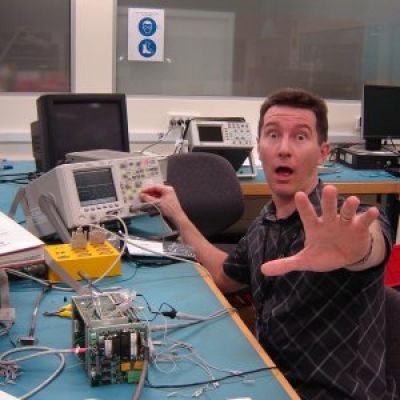Listen to your hosts Dave Jones & Chris Gammell talk about electronics design and the electronics industry in general. If you have any interest in electronics at all, from hobbyist/hacker/maker to engineering professional you'll find something of interest here.
https://theamphour.com
#519 – Simulating Embedded Hardware with Michael Gielda
Welcome Michael Gielda of Antmicro and the CHIPS Alliance!
- We were introduced to Michael by past guest Tim Ansell
- Antmicro was a founding member of RISC V, which they first found out about at a workshop at CERN
- Open RISC
- Renode is “a simulator to build embedded systems faster”
- Antmicro is a service organization at their core (contract/consulting services)
- They built Renode for themselves
- Edge AI systems
- CI – Continuous Integration
- Can simulate internal and external peripherals for a chip and board
- Abstracting building blocks
- Renode allows users to put things together in a config file
- They have been described as “The Docker of embedded”, which Michael says isn’t quite true, but shows that Antmicro works within the concept of Containerization
- Using Chris’s ABC board as an example
- We had previously talked about a remote testing setup on episode 512, and how Renode would replace that setup
- Users load their compiled binary into Renode.
- What can you “see” inside Renode?
- Packet analyzer like Wireshark
- There wasn’t a way to produce trace data, so they built something that extracts it from the simulated processor
- The Renode 1.11 release has metrics analysis
- Trace tracking
- Modeling an accelerometer
- Renode Platform File
- Everything becomes a test vector
- TFlite – Tensor Flow Lite
- esting gesture recognition
- Pareto
- Removing the human factor from the loop
- Test driven development
- Antmicro is “trying to make hardware boring”
- Networking is tough. What if you want to work with a bunch of devices networked together? Renode allows you to simulate multiple high level devices (like a dev board) talking to one another over a simulated network.
- Testing packet loss
- How do you validate that the simulation represents reality?
- Base the simulation data on datasheet
- Most systems are only using 10% of the chip (system), in terms of all
- Currently integrated into arduino
- HDL simulation (transistor level) using Verilator
- SiFive – FireSim
- Closing the feedback loop
- Silicon vendors didn’t give what the software people want
- Security domain – Dover use case. People prototyping performance.
- Polarfire SOC
- LiteX
- Working with Quick Logic
- PDK shuttle runs closing
- Open Fabric
- How do they decide on what to work on? “We look for things that are really broken and try to fix them”
- Working out in the open on CI for TF Lite
- “A society of tinkerers”
- CHIPS alliance aims to promote open source cores, interconect, and more…but also open source tooling
- It is a Linux Foundation project
- Intel AIB – developed the spec and code at the same time
- Would open source be possible in a place with vertical integration (ie Tesla), as we talked with Joris last week? “Open source achieves a common interface without the scale of Tesla”
- For more informtion, check out Antmicro.com
- Renode portable package
- Check out documentation
- One command to run the demo
- Looking for marketing people, but more broadly they are looking for people that believe in the mission of open source
Not discussed on the episode:
- Michael gave a talk/demo at FOSSi foundation
Many thanks to our Patrons! You can join at Patreon.com/TheAmpHour if you’d like to join the crowd. A special thanks to our corporate sponsor Binho, who now distribute the Sensepeek PCBite.
